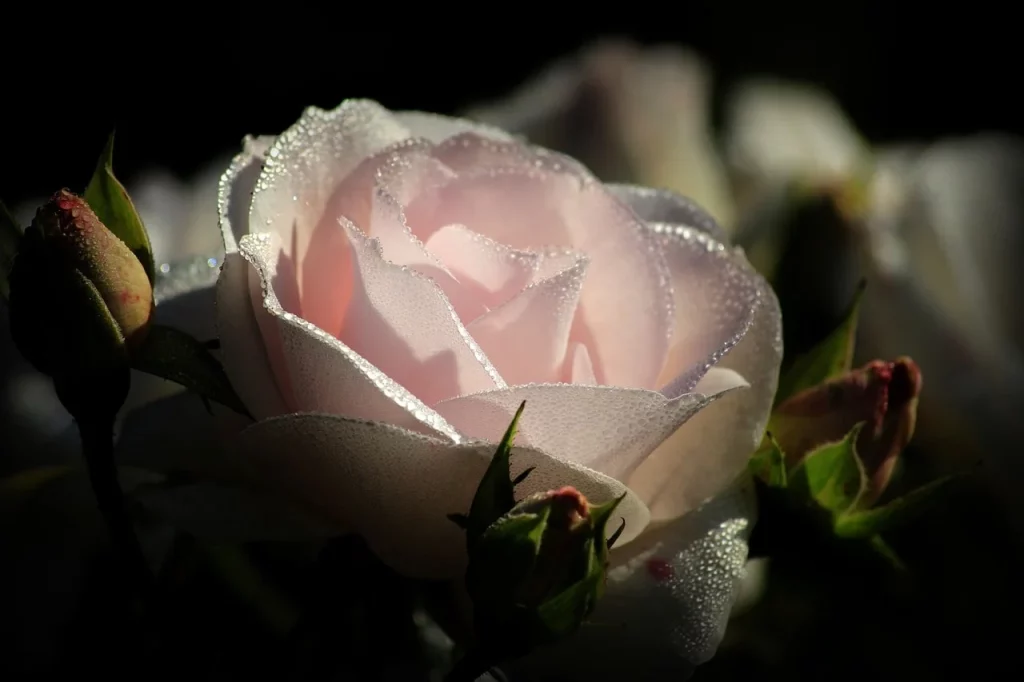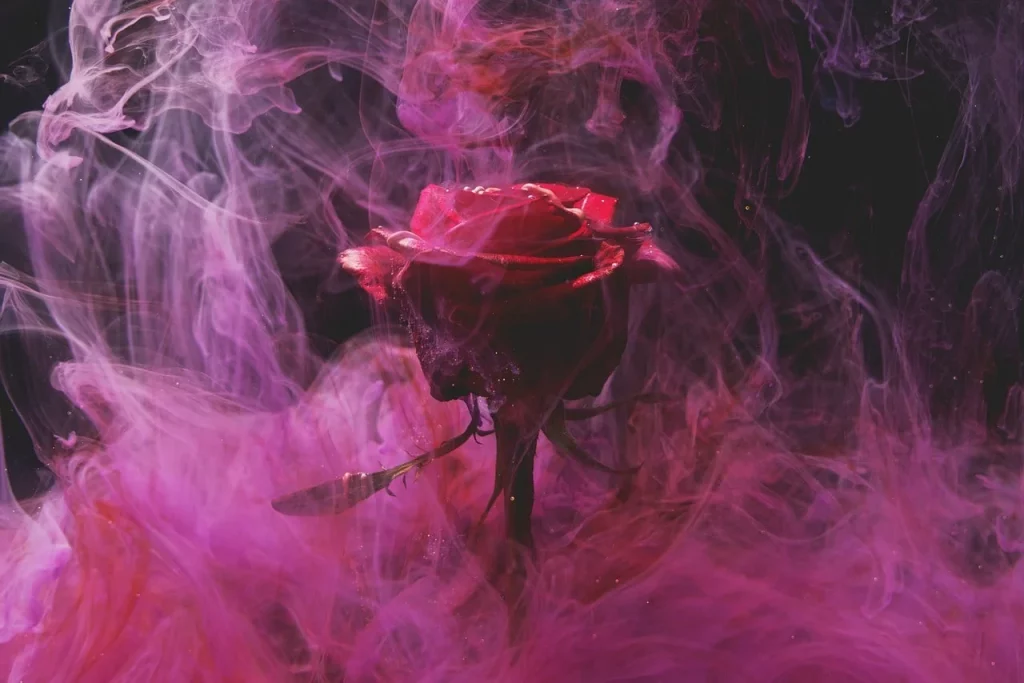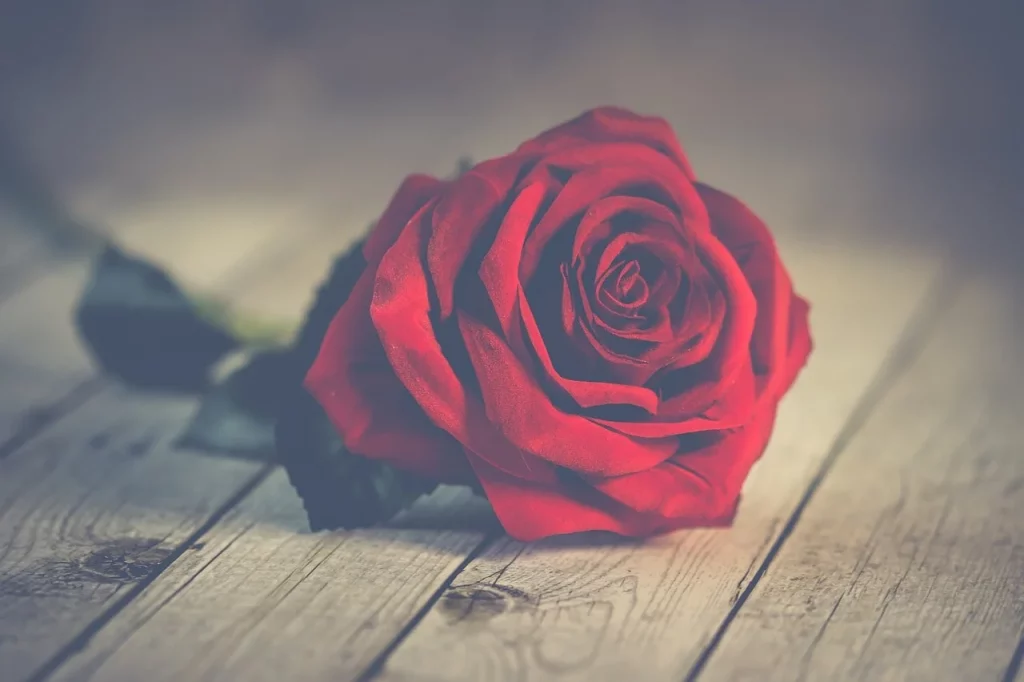Roses have been turning heads long before Instagram could turn anything into an instant celebrity. With their unparalleled beauty, intoxicating fragrance, and thorns that remind us that beauty often comes with its challenges, roses are nature’s way of showing off.
But did you know that beyond their show-stopping appearance, roses have some pretty quirky traits? From being able to grow as tall as a giraffe (well, almost) to having a connection with fruit you wouldn’t expect, these blooms are full of surprises.
As we embark on a journey through some fun facts about roses, you’ll discover that there’s much more to them than meets the eye. Have you ever thought a flower could be this interesting?
But he who dares not grasp the thorn Should never crave the rose.
Anne Brontë
Rose Facts
Dive into the vibrant world of roses, where each petal unfolds a story of beauty and history. Pay close attention to these facts because I created a quiz for you at the end of this article to test if you are an expert on the topic.
- The Rosa genus is believed to be 27 million years old, based on fossil evidence.
- George Washington was among the first to cultivate these flowers on American soil.
- The petals of these flowers can be edible and are often used in gourmet dishes.
- A single flower of the species Rosa sericea comes with only four petals.
- The largest private garden of these blooms is found in Cavriglia, Italy, covering over 80000 square meters.
- There’s a variety called ‘Juliet’ that took breeders 15 years and $5 million to create.
- In ancient Egypt, these blooms were considered sacred to the goddess Isis.
- Apple trees are part of the same family as these flowers.
- The oldest living plant of this species is 1000 years old and is located at Hildesheim Cathedral in Germany.
- Award-winning varieties often take up to 10 years to develop and can cost up to $150,000.
- During the 17th century, these flowers were so valuable that some were used as currency.
- The world record for the longest bloom stem is held by a flower measuring over 5.689 meters (18 feet 8 inches).
- There are over 100 species of these flowers, native to various parts of the world, including North America, Europe, and Asia.

- The flower’s hips are a rich source of Vitamin C and are used in teas, jams, and jellies.
- In the language of flowers, giving a single stem of this bloom means “I love you”.
- Some flowers of this type can produce a fruit that bears seeds, known as hips, which are often more colorful than the flowers themselves.
- Yellow varieties of these flowers were not known in the West until the 18th century and were brought from the Middle East.
- The Guinness World Record for the largest bouquet was made up of 156,940 blooms.
- The oil extracted from these flowers is incredibly valuable, requiring about 10,000 pounds of petals to produce one pound of oil.
- In ancient Rome, these flowers were often used as confetti at celebrations, for medicinal purposes, and as a source of perfume.
- The thorns of these flowers are actually considered prickles, technically outgrowths of the stem’s epidermis.
- One of the first known paintings of a rose dates back to 1700 BC in Crete.
- China is considered the largest producer of these flowers, primarily for perfume extraction.
- The use of these flowers in public ceremonies can be traced back to the ancient Greeks and Romans, who associated them with the goddess of love.
- There’s a variety known as “Green Rose,” which is unusual because its flowers are predominantly green.
- These flowers can live for a very long time; for instance, rose fossils have been found that are over 35 million years old.
- The process of breeding to create new varieties often involves hand pollination and careful selection over several years.
- The largest flower of this type on record was 33 inches in diameter.

- Roses were so revered in the ancient world that nobles of the Roman Empire would lie on rose petal-filled mattresses.
- In the Middle Ages, these flowers were symbolically used to represent the blood of Christians martyred by the Romans.
- Some cultures believe that these flowers can protect against evil spirits.
- It’s possible for these flowers to grow from cuttings of the stem placed in potatoes.
- The color of these flowers can symbolize different emotions: red for love, yellow for friendship, and black for death or farewell.
- A rare variety found in Turkey, known as the “Halfeti Rose,” appears black but is actually a deep reddish-purple.
- These flowers have been sent into space to study the effects of low gravity on plant growth.
- The practice of cultivating these flowers for ornamental purposes dates back at least 5,000 years.
- Rose water, a byproduct of oil distillation, is widely used in Middle Eastern cuisine.
- The first patented variety of this flower was ‘La France’ in 1867.

- In the 15th century, these flowers were symbolic of the factions fighting to control England, known as the War of the Roses.
- The most expensive variety ever sold was named after the famous painter, Claude Monet.
- These flowers have been used in herbal and traditional medicines across the world for centuries.
- Their patterns have been found on ancient coins, signifying beauty and the fleeting nature of life.
- Ancient civilizations used the petals of these flowers to fill pillows and mattresses, believing in their soothing properties.
- Botanically speaking, these flowers are closely related to almonds, cherries, peaches, and plums.
- Despite their fragile appearance, some species can survive extreme cold temperatures, even below -20°F.
- Hybridization techniques have led to varieties that bloom multiple times a year, a trait not found in their wild counterparts.
- The world’s most famous gardens, from Versailles to the White House, feature these flowers prominently.
- Some species can grow to over 50 feet tall, climbing and covering buildings, trees, and walls.
- The scent of these flowers can vary greatly, with some varieties bred specifically for their strong and unique fragrances, such as the ‘Damask’, known for its rich, intoxicating aroma.
- There’s a phenomenon known as “rose rustling,” where enthusiasts seek out and propagate old and rare varieties from abandoned or historical sites to preserve genetic diversity.
Rose Myths

Having explored interesting facts about roses, let’s now navigate the line between reality and myth. This next section aims to separate the truth from the widespread myths that surround these enchanting flowers.
- Roses Only Bloom Once a Year
Many rose varieties, especially modern hybrids, are bred for repeat flowering. They are known to bloom multiple times throughout the growing season, from spring to fall. This characteristic is particularly prominent in floribunda and grandiflora types. - Roses Require Constant, Intensive Care
While it’s true that they appreciate attention, numerous varieties have been developed to be disease-resistant and low-maintenance. These hardy types are often capable of thriving with just basic care, such as occasional watering, fertilizing, and pruning. - All Roses Prefer Full Sun
Although most varieties perform best in full sun, receiving at least six hours of direct sunlight daily, some are quite adaptable to partial shade. Shade-tolerant roses can still produce beautiful blooms, even in less than ideal light conditions. - Roses Are Always High Maintenance
The reputation of them as high-maintenance plants has been challenged by the introduction of easy-care varieties like the Knock Out series. These roses are celebrated for their disease resistance, continuous blooming, and minimal care requirements. - Deadheading Roses is Optional
Deadheading, or the removal of spent flowers, is recommended for many types of roses to encourage reblooming and maintain plant health. It helps to prevent energy from being wasted on seed production, directing it towards new growth and blooms instead.
No products found.
Rose Quotes

Let me share with you my collection of quotes. Feel free to share your favorite ones in the comments so I can add them to the list as well.
A rose’s rarest essence lives in the thorn.
Rumi
Rumi speaks to the paradox of beauty and pain, suggesting the deepest beauty has its roots in adversity.
What’s in a name? That which we call a rose by any other name would smell as sweet.
William Shakespeare
William Shakespeare muses on the irrelevance of labels compared to the inherent qualities of things, using a rose to illustrate his point.
We can complain because rose bushes have thorns, or rejoice because thorns have roses.
Alphonse Karr
Alphonse Karr offers a perspective on optimism, encouraging us to appreciate the beauty in life despite its challenges.
The rose does not bloom without thorns. True, but would that the thorns did not outlive the rose.
Richter
Richter reflects on the transient beauty of life and the lasting nature of hardship, using the rose as a metaphor.
True friendship is like a rose: we don’t realize its beauty until it fades.
Evelyn Loeb
Evelyn Loeb draws a comparison between the evolving nature of friendship and the fleeting beauty of a rose, noting that the value of both is often appreciated in retrospect.
Rose FAQ

Having explored the depth of roses through quotes, we now enter the FAQ section. Read closely—these details are your stepping stones to acing the quiz that follows.
- Which rose smells the best?
Ah, the quest for the most fragrant one! While scent is subjective, the Damask rose (Rosa damascena) often tops the list. It’s celebrated for its deep, intoxicating fragrance and is commonly used in perfumery. But really, the best-smelling one might just be the one that tickles your nose the happiest! - Are rose leaves toxic to cats?
Good news for your feline friends! Rose leaves are generally considered non-toxic to cats. However, it’s wise to prevent them from nibbling too much, as the thorns can be harmful, and any plant material might upset their little stomachs. - How often should roses be watered?
They love their water, but they dislike soggy feet. Typically, watering them deeply once a week should suffice. During hot, dry spells, they might appreciate a bit more H2O. Remember, it’s all about keeping the soil moist but not waterlogged. - Are rose petals edible?
Absolutely! Rose petals are not just edible; they’re a delight. You can sprinkle them over salads, blend them into smoothies, or even use them to make rose water. Just make sure they’re free from pesticides. - When is the best time to plant roses?
Spring or fall, when the weather is cooler, is ideal for planting them. This gives them a chance to establish roots before the stress of summer heat or winter cold. Just ensure there’s no risk of frost when you decide to plant.
No products found.
Rose Trivia

Welcome to our Rose Quiz! Remember, if you don’t get at least one question right, you might find your garden mysteriously overrun by dandelions overnight!
Conclusion
In closing, it’s evident that roses are far more than just symbols of love and beauty. From their unexpected toughness to their role in history and medicine, these flowers weave a rich tapestry of stories and uses that span centuries.
Reflecting on the myriad of facts we’ve uncovered, it’s impossible not to admire the resilience and versatility of roses. They’re not just the stars of gardens and romantic gestures; they’re historical icons, medicinal marvels, and culinary surprises.
So, the next time you stop to smell some roses, remember that you’re not just enjoying their fragrance; you’re connecting with a legacy that’s as vibrant and enduring as the flowers themselves. Till next time, stay curious and explore more. Cheers.


